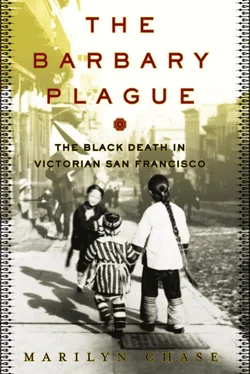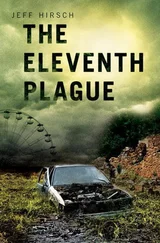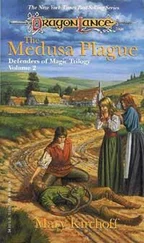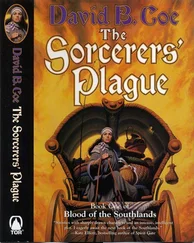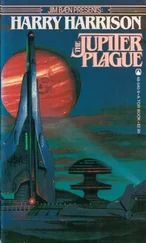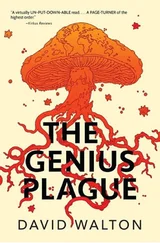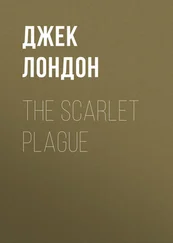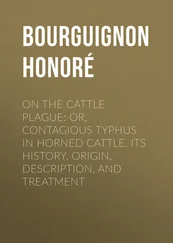Kinyoun wired the first of a string of telegrams conveying the alarming news to Dr. Wyman in federal code, using strange phrases like “suspected bumpkin.” 17
Translated, the word bumpkin meant plague. Suspected plague in Chinatown. The encrypted messages eluded the Western Union operators and reporters hanging around the telegraph office. Singing over the wires, the messages traveled eastward over the cryptic signature of Kinyoun under his code name, “Abutment.”
Downtown, the San Francisco Chronicle and other papers ridiculed the plague scare as a comic opera, a bubonic opera buffa. Political pundits believed the quarantine was a bit of jobbery staged to win funds and clout for the city’s board of health. There were jokes about the “bubonic board of health.” Kinyoun was branded a charlatan. The San Francisco Bulletin lampooned him in a rollicking rhyme:
Have you heard of the deadly bacillus,
Scourge of a populous land,
Bacillus that threatens to kill us,
When found in a Chinaman’s gland?…
Well the monkey is living and thriving,
The guinea pigs seem to be well,
And the Health Board is vainly contriving
Excuses for having raised… 18
Inside Chinatown, it was hell. Anxious, hungry, fearing for their lost wages and unattended jobs, the Chinese were sick with dread. Those who believed the disease was plague feared being trapped in the infected zone. Those who doubted that plague was real—by all accounts, the majority—feared that the quarantine was merely a pretext for more discrimination, a prelude to fire or demolition, imprisonment or detention. Discrimination was the bitter taste they swallowed with their daily rice, but who knew what new torments the whites might contrive? Outside the quarantine, whites chafed at the inconvenience of it all: Launderers, cooks, and laborers were absent from duty. Hostesses and hoteliers found meager pickings without their chefs and servants. Guests in downtown hostelries went hungry because kitchen staffs were trapped inside the barricades. Food, mail, and supplies were passed between the zones with difficulty or not at all.
After three days of quarantine, no new cases of the so-called plague had materialized. The test animals were still alive. Moreover, the Chinese were threatening to file a lawsuit protesting the blockade and asking for damages. The city health department now felt foolish and had no choice but to lift the quarantine.
Rumors of the blockade’s end brought people pouring into the streets of Chinatown in anticipation of freedom. At four P.M. on March 10, the cordons came down and cheers went up. Thousands of Chinese flowed from the quarantined zone into greater San Francisco. Food deliveries recommenced. Men went back to work in hotels and kitchens all over town. Whites, too, cheered the end of their disrupted dinners. The Examiner published a celebratory verse.
THE RAISING OF THE QUARANTINE
Sweet Fong is at his post once more
And cooking reigns supreme;
Once more upon the kitchen range
A wealth of viands steam,
And joyful Plenty smiles again
Where Famine’s hand was laid;
For, lo! The Board of Health has raised
The Chinatown blockade. 19
But the poems and jokes, the cheers and celebration, were premature.
Two days later, on March 12, the scuffling and scrabbling animals inside the cages of the Angel Island lab went silent. When Kinyoun looked in, he found the rat and the guinea pigs lying cold in their cages. The monkey grew listless, hung his head, and died the next day.
The Boy from Catfish Creek

WHILE KINYOUN BROODED OVERhis plague experiments on fogbound Angel Island, another doctor kept watch over the sunstruck Mediterranean from his post in Genoa, Italy. If Kinyoun was a prodigy, thirty-two-year-old Rupert Lee Blue was a late bloomer just coming into flower. He too had recently been dispatched by the Marine Hospital Service to a remote lookout for epidemics. On June 27, 1900, Blue picked up a local newspaper and read a report that made his pulse quicken: A dozen people had fallen sick and three were dead of bubonic plague in Greece and Turkey. He dashed off a dispatch to Washington.
“The bubonic pest is slowly marching Northward along the Levantine shore and invading Europe from the East,” he wrote to the surgeon general. 1His prediction of an epidemic storming the gates of Europe was grippingly phrased to catch the eye of his boss, Walter Wyman, but it turned out to be a false alarm. A dozen cases on the Aegean coast didn’t herald the return of the Black Death to Europe.
Still, Blue was right to be on the alert. Since biblical times, plague had sown death around the world in sweeping pandemics—super-epidemics—three times over two millennia. As a Sunday schooler, Blue had no doubt read the Book of Samuel’s passage about a plague among the Philistines, who suffered “emerods in their secret parts,” a poetic description of the signature symptom—buboes, or swollen glands, in the hollows of the groin and armpits that give the disease its name. In the sixth century, Justinian’s Plague took nearly one hundred million lives in Asia, Africa, and Europe. In the fourteenth century, the plague pandemic known as the Black Death killed fifty million victims, including a quarter of Europe’s population. Aftershocks were felt for centuries, in outbreaks like the great plague of London in 1665.
Now, the third plague pandemic, centered in Hong Kong in 1894, was spreading along the trade routes. While plague once traveled on the wind that drove sailing ships, it now migrated at twentieth-century speed aboard new coal-fired steamships. 2
Its symptoms were violent: Rampant fever, crushing headache, overwhelming nausea, and profound weakness swept over a person who had been strong only hours before. Inflamed lymph glands struggled to contain the invading bacteria. Wherever they swelled, a painful red bubo erupted. Inky hemorrhages burst from small vessels, staining the skin with blue-black tattoos—the fearful “tokens” of Black Death. The pulse galloped at first, then later dwindled to a thread dancing beneath the doctor’s finger. Delirium and pain unhinged the mind and stirred the limbs in an agitated dance of death. Victims in their final agony plucked at the bedclothes, unable to bear the slightest touch on their swellings.
Plague’s only mercy was its speedy end. When buboes were the main symptom, plague killed in five days. If a victim was spitting blood, a symptom of plague in the lungs, death came in two or three days. So-called pneumonic plague was the rarest and deadliest form of the disease. It was also the only form now known to be contagious, spread from person to person by saliva as the coughing victims helplessly infected caretakers and family. Bubonic or pneumonic, it all started from the same germ, the bacteria known, variously, as Bacillus pestis and Yersinia pestis .
More terrible than the scourge itself was the effect it had on the psyche: It turned humans into beasts. Giovanni Boccaccio gives an eyewitness account of plague-stricken Florence in his preface to The Decameron , describing how the sick were abandoned in agony, corpses layered in mass graves, and princely palaces left empty:
…[T]hings had reached the point where the dying received no more consideration than the odd goat would today…. As there was not sufficient consecrated ground in which to bury the vast number of corpses that arrived at every church day after day and practically hour by hour… enormous pits were dug in graveyards, once saturation point had been reached, and the new arrivals were dropped into these by the hundred; here they were packed in layers, the way goods are stowed in a ship’s hold, and each layer would get a thin layer of earth until the pit was filled up. 3
Читать дальше
